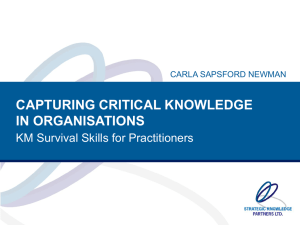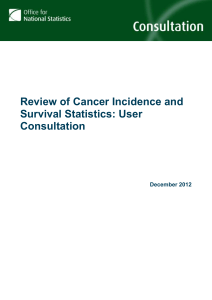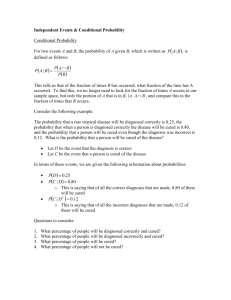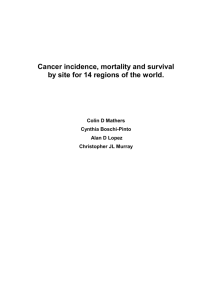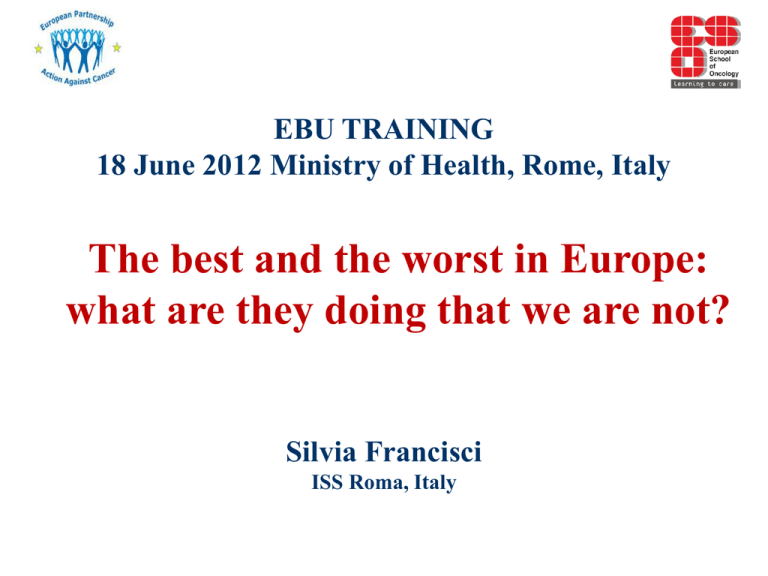
EBU TRAINING
18 June 2012 Ministry of Health, Rome, Italy
The best and the worst in Europe:
what are they doing that we are not?
Silvia Francisci
ISS Roma, Italy
Comparisons: why?
Comparing the major cancer burden indicators in
different countries for the various cancer types
can give you an idea of where improvements
could be made, and help to learn from the
successes of other countries – What are they doing
right that we are not?
Comparing within a single country over time can
show whether and how fast things are improving,
which is important to evaluate how well cancer
plans and policies are working
Cancer burden indicators: Incidence, Mortality
• Incidence rate is the number of new cancers of a
specific site/type occurring in a specified population
during a year, it is usually expressed as the number of
cancers per 100,000 population at risk represents a
measure of risk in a population and depends on the
distribution of risk factors
• Mortality rate is the number of deaths, with cancer as
the underlying cause of death, occurring in a specified
population during a year. Cancer mortality is usually
expressed as the number of deaths due to cancer per
100,000 population represents measure of final
outcome and depends on timeliness of diagnosis/care
and effectiveness of treatment
Crude rates
Incidence and
Mortality by country:
Colorectal cancer
STD rates
The effect of age structure
adjustement on geographical
ranking
Cervix uteri cancer incidence per 100000
40
30
Bulgaria
Estonia
Finland
Greece
Hungary
Latvia
Lithuania
Norway
Romania
Slovakia
Slovenia
Switzerland
20
10
0
2000
2005
2010
2015
Arbyn, EJC 2009
Incidence
Risk increase or PSA effect?
Mortality
Cancer burden indicators: Survival
– Cause of death known Cancer Specific Survival probability
of surviving cancer after x years from diagnosis in a cohort of
patients diagnosed in a period of time t
– Cause of death unknown Relative Survival (RS)
ratio of the observed survival in the patients group to the
expected survival in a similar group in the population (same
age, sex, year, area, socio-economic class etc…)
– RS measures the extra-risk of dying of cancer patients by
removing the competitive mortality due to causes other than
cancer. It approximates a NET SURVIVAL measure.
EUROCARE-5
104 adult + 9 Childhood CRs
About 21 milion cases in the DB
National coverage in 20
countries: 140 million
population
Partial coverage:
Italy, France, Spain, Portugal, Germany,
Switzerland, Belgium, Poland, Romania:
113 million population (34% of the
total)
EUROCARE-5 Increased number of
countries/registries, expecially eastern
European countries
Population-based cancer registry:
data quality issues
1. Completeness of incidence
2. Completeness and quality of follow-up
3. Standard quality indicators (Death Certificate
Only cases, Microscopically Verified,
morphology NOS)
ensure comparability of results
4. Additional variables: stage at diagnosis,
treatments
facilitate interpretation of results
5-year Relative Survival cohort 1995-99 all cancers
Berrino F, Lancet Oncology (2007) – EUROCARE 4 STUDY
5-year RS Trend 1989-1998, all cancers, by country
Verdecchia A, European Journal of Cancer (2009) – EUROCARE-4 STUDY
Cancer burden indicators:
Prevalence
The number of surviving cancer patients in a population at a
defined index date.
Population
Survival
Incidence
Ageing
Prevalence
Cancer burden indicators: Prevalence
– Total (or complete) prevalence involves all
survivors irrespectively of the date of diagnosis.
– Partial (or Limited Duration) prevalence by
years from diagnosis represents the number of
survivors by limited disease duration.
• 1-2 years LD patients under main treatment
and rehabilitation
• 3-5 years LD patients under clinical followup for recurrences and metastasis
• 5-10 years LD patients that are possibly
cured
Prevalence in Italy (2006),
Nordic countries (2006) and
UK (2008)
Data sources:
Italy: PIO 7 project and Italian Associationof Cancer
Registries. Prevalence date: 1-1-2006
Nordic countries: Engholm G, Ferlay J, Christensen N,
Bray F, Gjerstorff ML, Klint A, Køtlum JE, Olafsdóttir E,
Pukkala E, Storm HH (2010). NORDCAN-a Nordic tool for
cancer information, planning, quality control and research.
Acta Oncol. 2010 Jun;49(5):725-36.
UK: Maddams J, Brewster D, Gavin A, Steward J, Elliott J,
Utley M, and Møller H. Cancer prevalence in the United
Kingdom. Br J Cancer 2009 Aug 4;101(3):541-7
Cancer burden indicators: cure fraction
• Modelling survival allows to estimate another
important indicator of cancer burden: the
fraction of patients cured from the disease
• Cure fraction P measures the proportion of
patients which do not show an extra-risk of
death with respect to a comparable groups in the
general population (statistical definition of cure)
• P is an indicator not influenced by lead time
bias (diagnostic anticipation without real
survival improvement)
As cancer diagnostic
procedures and treatments
improve, the possibility of
cure for many cancers
becomes a reality.
CURE FRACTION
P
0,9
0,8
The cure fraction (P), is
the survival level as the
curve (CRS) flattens
CRS
0,7
0,6
Higher survival levels
correspond to wider cured
fractions
55% cured
0,5
45% cured
0,4
35% cured
0,3
0
2
4
6
8
10
12
follow-up year
14
16
18
20
Cure fraction colorectal cancer patients
DENMARK
FINLAND
Colorectal cancer cure fraction is
increasing over time
ICELAND
NORWAY
SWEDEN
ENGLAND
SCOTLAND
2.50
WALES
AUSTRIA
FRANCE
GERMANY
NETHERLAND
POLAND
SPAIN
SWITZERL
ITALY
SLOVENIA
CZECH REPUBLIC
0
10
20
30
40
50
60
On average 45% of patients are cured
There is large variability across European countries
Life expectancy of fatal cases (years)
2.40
Colorectum
2.30
2.20
2.10
1994-96
2.00
1.90
1991-93
1.80
1988-90
1.70
1.60
1.50
40%
Francisci et al. EJC (2009)
1997-99
42%
44%
46%
Cured patients (%)
48%
50%
Avoidable deaths
Ellis, European Journal of Cancer 2012
Avoidable deaths in England
• Improvement in
survival overall
• Narrowing of the
deficit between
socio-economic
groups (only 2% of
reduction)
Ellis, European Journal of Cancer 2012
Discussion
• The overall set of descriptive indicators provide a
comprehensive picture of cancer burden
• The comprehensive description of cancer burden is
important in order to inform health policy and to properly
address cancer plans
• Comparisons across Europe are needed in order to
• validate national data
• identify opportunities to improve health care
• revise guidelines and practice patterns
• increase our understanding of patient outcomes and
economic consequences of different policies related to
cancer screening, treatment, and programs of care







